2015年高考英语全国1卷试题及答案
- 格式:doc
- 大小:1.35 MB
- 文档页数:9
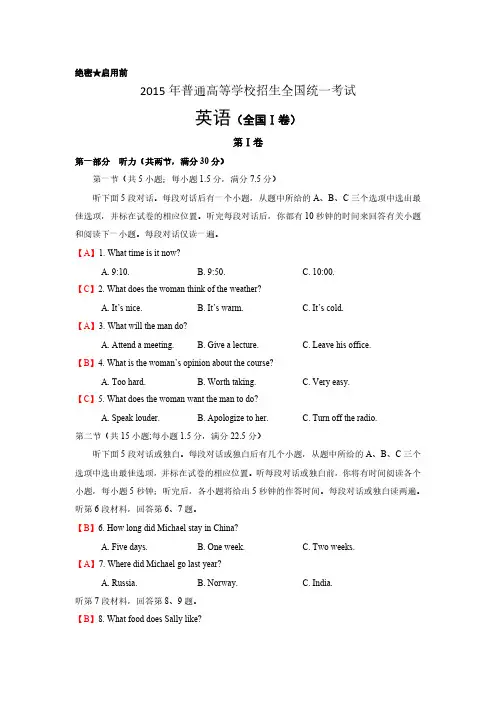
绝密★启用前2015年普通高等学校招生全国统一考试英语(全国Ⅰ卷)第Ⅰ卷第一部分听力(共两节,满分30分)第一节(共5小题;每小题1.5分,满分7.5分)听下面5段对话。
每段对话后有一个小题,从题中所给的A、B、C三个选项中选出最佳选项,并标在试卷的相应位置。
听完每段对话后,你都有10秒钟的时间来回答有关小题和阅读下一小题。
每段对话仅读一遍。
【A】1. What time is it now?A. 9:10.B. 9:50.C. 10:00.【C】2. What does the woman think of the weather?A. It’s nice.B. It’s warm.C. It’s cold.【A】3. What will the man do?A. Attend a meeting.B. Give a lecture.C. Leave his office.【B】4. What is the woman’s opinion about the course?A. Too hard.B. Worth taking.C. Very easy.【C】5. What does the woman want the man to do?A. Speak louder.B. Apologize to her.C. Turn off the radio.第二节(共15小题;每小题1.5分,满分22.5分)听下面5段对话或独白。
每段对话或独白后有几个小题,从题中所给的A、B、C三个选项中选出最佳选项,并标在试卷的相应位置。
听每段对话或独白前,你将有时间阅读各个小题,每小题5秒钟;听完后,各小题将给出5秒钟的作答时间。
每段对话或独白读两遍。
听第6段材料,回答第6、7题。
【B】6. How long did Michael stay in China?A. Five days.B. One week.C. Two weeks.【A】7. Where did Michael go last year?A. Russia.B. Norway.C. India.听第7段材料,回答第8、9题。

2015年高考真题及答案—英语(新课标I卷)试题类型:A 2015年普通高等学校招生全国统一考试(新课标I)英语注意事项:1. 本试卷分第Ⅰ卷(选择题)和第Ⅱ卷(非选择题)两部分。
2. 答题前,考生务必将自己的姓名、准考证号填写在本试卷相应的位置。
3. 全部答案在答题卡上完成,答在本试卷上无效。
4. 第Ⅰ卷听力部分满分30分,不计入总分,考试成绩录取时提供给高校作参考。
5. 考试结束后,将本试卷和答题卡一并交回。
第Ⅰ卷第一部分听力(共两节,满分30分)做题时,先将答案标在试卷上,录音内容结束后,你将有两分钟的时间将试卷上的答案转涂到答题卡上。
第一节(共5小题;每小题1.5分,满分7.5分)听下面5段对话,每段对话后有一个小题。
从题中所给的A、B、C三个选项中选出最佳选项,并标在试卷的相应位置。
听完每段对话后,你都有10秒钟的时间来回答有关小题和阅读下一小题。
每段对话仅读一遍。
例:How much is the shirt?A.£ 19.15B.£ 9.18C.£ 9.15答案是C。
1. What time is it now?A.9:10B.9:50C.10:002. What does the woman think of the weather?A. It’s nice.B. It’s warmC. It’s cold3. What will the man do?A. Attend a meeting.B. Give a lectureC. Leave his office.4. What is the woman’s opinion about the course?A. Too hard.B. Worth taking.C. Very easy.5. What does the woman want the man to do?A. Speak louder.B. Apologize to her.C. Turn off the radio.第二节(共15小题;每小题1.5分,满分22.5分)听下面5段对话或独白。
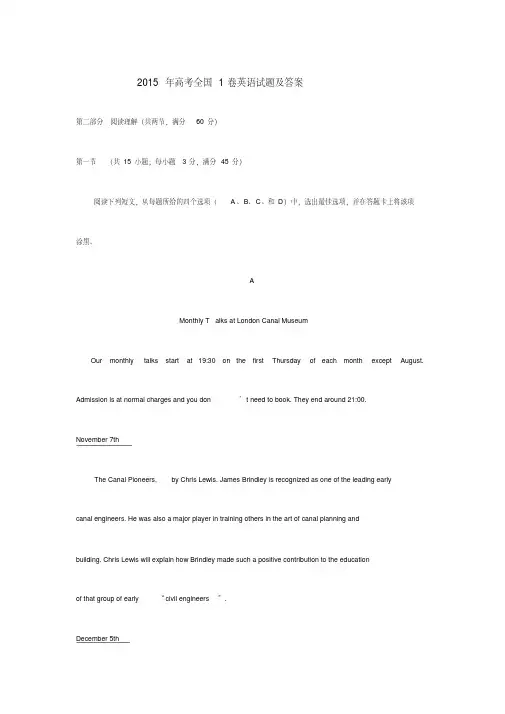

英语试卷 第1页(共22页)英语试卷 第2页(共22页)绝密★启用前2015普通高等学校招生全国统一考试(全国新课标卷1)英语使用地区:河南、山西、河北、江西、山东本试卷分第Ⅰ卷(选择题)和第Ⅱ卷(非选择题)两部分。
共150分,共12页。
考试时间结束后,将本试卷和答题卡一并交回。
注意事项:1. 答题前,考生先将自己的姓名、准考证号码填写清楚,将条形码准确粘贴在条形码区域内。
2. 选择题必须使用2B 铅笔填涂;非选择题必须使用0.5毫米黑色字迹的签字笔书写,字体工整、笔迹清楚。
3. 请按照题号顺序在各题目的答题区域内作答,超出答题区域书写的答案无效;在草稿纸、试题卷上答题无效。
4. 保持卡面清洁,不要折叠、不要弄破、弄皱,不准使用涂改液、修正带、刮纸刀。
注:山西卷赋分不同,满分180分。
听力30分不计入总分,考试成绩录取时提供给高校作参考。
第Ⅰ卷第一部分 听力(共两节,满分30分)做题时,先将答案标在试卷上。
录音内容结束后,你将有两分钟的时间将试卷上的答案转涂到答题卡上。
第一节 (共5小题;每小题1.5分,满分7.5分)听下面5段对话。
每段对话后有一个小题,从题中所给的A 、B 、C 三个选项中选出最佳选项,并标在试卷的相应位置。
听完每段对话后,你都有10秒钟的时间来回答有关小题和阅读下一小题。
每段对话仅读一遍。
例: How much is the shirt? A. £19.15.B. £9. 18.C. £9.15.答案是C 。
1. What time is it now? A. 9:10.B. 9:50.C. 10:00.2. What does the woman think of the weather? A. It’s nice.B. It’s warm.C. It’s cold.3. What will the man do? A. Attend a meeting.B. Give a lecture.C. Leave his office.4. What is the woman’s opinion about the course? A. Too hard.B. Worth taking.C. Very easy.5. What does the woman want the man to do? A. Speak louder.B. Apologize to her.C. Turn off the radio.第二节 (共15小题;每小题1.5分,满分22.5分)听下面5段对话或独白。
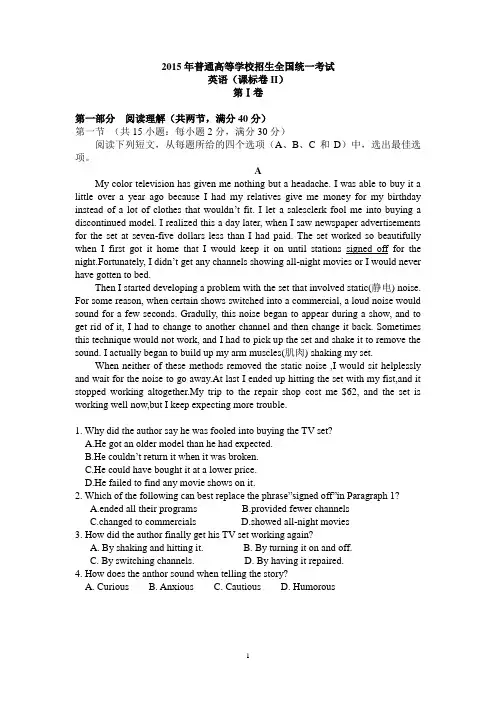
2015年普通高等学校招生全国统一考试英语(课标卷II)第Ⅰ卷第一部分阅读理解(共两节,满分40分)第一节(共15小题:每小题2分,满分30分)阅读下列短文,从每题所给的四个选项(A、B、C和D)中,选出最佳选项。
AMy color television has given me nothing but a headache. I was able to buy it a little over a year ago because I had my relatives give me money for my birthday instead of a lot of clothes that wouldn’t fit. I let a salesclerk fool me into buying a discontinued model. I realized this a day later, when I saw newspaper advertisements for the set at seven-five dollars less than I had paid. The set worked so beautifully when I first got it home that I would keep it on until stations signed off for the night.Fortunately, I didn’t get any channels showing all-night movies or I would never have gotten to bed.Then I started developing a problem with the set that involved static(静电) noise. For some reason, when certain shows switched into a commercial, a loud noise would sound for a few seconds. Gradully, this noise began to appear during a show, and to get rid of it, I had to change to another channel and then change it back. Sometimes this technique would not work, and I had to pick up the set and shake it to remove the sound. I actually began to build up my arm muscles(肌肉) shaking my set.When neither of these methods removed the static noise ,I would sit helplessly and wait for the noise to go away.At last I ended up hitting the set with my fist,and it stopped working altogether.My trip to the repair shop cost me $62, and the set is working well now,but I keep expecting more trouble.1. Why did the author say he was fooled into buying the TV set?A.He got an older model than he had expected.B.He couldn’t return it when it was broken.C.He could have bought it at a lower price.D.He failed to find any movie shows on it.2. Which of the followi ng can best replace the phrase”signed off”in Paragraph 1?A.ended all their programsB.provided fewer channelsC.changed to commercialsD.showed all-night movies3. How did the author finally get his TV set working again?A. By shaking and hitting it.B. By turning it on and off.C. By switching channels.D. By having it repaired.4. How does the anthor sound when telling the story?A. CuriousB. AnxiousC. CautiousD. HumorousYour house may have an effect on your figure. Experts say the way you design your home could play a role in whether you pack on the pounds or keep them off. You can make your environment work for you instead of against you. Here are some ways to turn your home into part of diet plan.Open the curtains and turn up the lights. Dark environments are more likely to encourage overeating , for people are often less self-conscious(难为情)when they’re in poorly lit places-and so more likely to eat lots of food . If your home doesn’t have enough window light, get more lamps and flood the place with brightness.Mind the colors. Research suggests warm colors fuel our appetites. In one study , people who ate meals in a blue room consumed 33 percent less than those in a yellow or red room . Warm colors like yellow make food appear more appetizing , while cold colors make us feel less hungry . So when it’s time to repaint, go blue.Don’t forget the clock-or the radio. People who eat slowly tend to consume about 70 fewer calories(卡路里)per meal than those who rush through their meals. Begin keeping track of the time, and try to make dinner last at least 30 minutes. And while you’re at it, actually sit down to eat. If you need some help slowing down, turn on relaxing music. It makes you less likely to rush through a meal.Downsize the dishs. Big serving bowls and plates can easily make us fat. We eat about 22 percent more when using a 12-inch plate instead of a 10-inch plate. When we choose a large spoon over a smaller one ,total intake(摄入)jumps by 14 percent. And we’ll pour about 30 percent more liquid into a short, wide glass than a tall, skinny glass.5. The text is especially helpful for those who care about_______.A. their home comfortsB. their body shapeC. house buyingD. healthy diets6. A home environment in blue can help people_________.A.digest food betterB.reduce food intakeC.burn more caloriesD.regain their appetites7. What are people advised to do at mealtimes?A. Eat quickly.B. Play fast music.C. Use smaller spoons.D. Turn down the lights.8. What can be a suitable title for the test?A.Is Your Hourse Making You Fat?B.Ways of Serving DinnerC.Effects of Self-ConsciousnessD. Is Your Home Environment Relaxing?More student than ever cefore are taking a gap-year (间隔年)before going to university.It used to be called the “year off”between school and university.The gap-year phenomenon originated(起源) with the months left over to Oxbridge applicants between entrance exams in November and the start of the next academic year.This year, 25,310 students who have accepted places in higher education institutions have put off their entry until next year, according to statistics on university entrance provided by the University and College Admissions Service(UCAS).That is a record 14.7% increase in the number of students taking a gap year. Tony Higgins from UCAS said that the statistics are good news for everyone in higher education. “Students who take a well-planned year out are more likely to be satisfied with, and complete, their chosen course. Students who take a gap year are often more mature and responsible,” he said.But not everyone is happy. Owain James, the president of the National Union of Students (NUS), argued that the increase is evidence of student hadship –young people are being forced into earning money before finishing their education.“New students are now aware that they are likely to leave university up to £15,000 in debt. It is not surprising that more and more students are taking a gap year to earn money to support their study for the degree.NUS statistics show that over 40% of students are forced to work during term time and the figure increases to 90% during vacation periods,”he said.9. What do we learn about the gap year from the text?A. It is flexible in length.B. It is a time for relaxation.C. It is increasingly popular.D. It is required by universities.10. According to Tony Higgins, students taking a gap year______.A.are better prepared for college studiesB.know a lot more about their future jobsC.are more likely to leave university in debtD.have a better chance to enter top universities11. How does Owain James feel about the gap-year phenomenon?A. He's puzzled.B. He's worried.C. He's surprised.D. He's annoyed.12. What would most students do on their vacation according to NUS statistics?A. Attend additional courses.B. Make plans for the new term.C. Earn money for their education.D.Prepare for their graduate studies.Choose Your One-Day Tours!Tour A-Bath & Stonchenge including entrance fees to the ancient Roman bathrooms and Stonehenge-£37until 26 March and £39 thereafter.Visit the city with over 2,000 years of history and Bath Abbey,the Royal Crescent and the Costume Museum.Stonehenge is one of the world’s most famous prehistoric monuments dating back over 5,000 years.Tour B-Oxford & Stratford including entrance fees to the University St Mary’s Church Tower and Anne Hathaway's house-£32until 12 March and -£36 thereafter.Oxford:Includes a guided of England’s oldest university cit y and colleges. Look over the “city of dreaming spires(尖顶)”form St Mary’s Church Tower. Stratford:Includes a guided tour exploring much of the Shakespeare wonder. Tour C—Windsor Castle & Hampton Court including entrance fees to Hampton Court Palace-£34 until 11 March and -£37 thereafter.Includes a guided tour of Windsor and Hampton Court, Henry Vill’s favourite palace. Free time to visit Windsor Castle(entrace fees not included). With 500 years of history, Hampton Court was once the home of four Kings and one Queen. Now this former royal palace is open to the public as a major tourist attraction. Visit the palace and its various historic gardens, which include the famous maze(迷宫)where it is easy to get lost!Tour D-Cambridge including entrance fees to the Tower of Saint Mary the Great-£33 until 18 March and £37 thereafter.Includes a guided tour of Cambridge, the famous university town, and the gardens of the 18th century.13. Which tour will you choose if you want to see England’s oldest universi ty city?A.Tour AB.Tour BC.Tour CD.Tour D14. Which of the following tours charges the lowest fee on 17 March?A. Windsor Castle & Hampton Court.B.Oxford & StratfordC. Bath &Stonehenge.D. Cambridge.15. Why is Hampton Court a major tourist attraction?A.It used to be the home of royal families.B.It used to be a well-known mazeC.It is the oldest palace in BritainD.It is a world-famous castle.第二节(共5小题:每小题2分,满分10分)根据短文内容,从短文后的选项中选出能填入空白处的最佳选项。
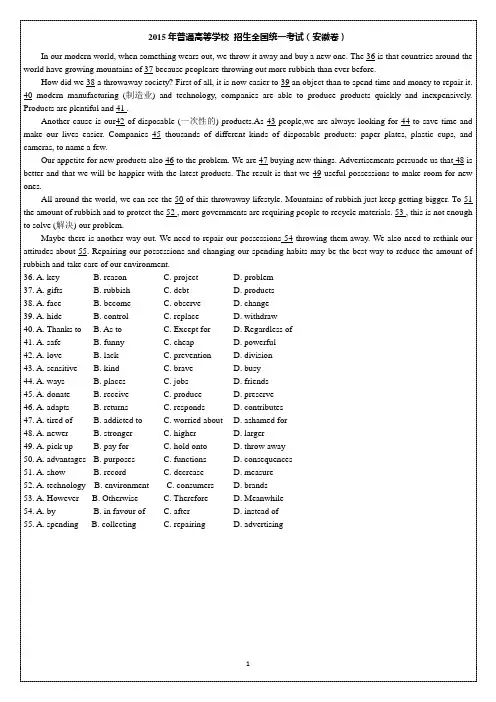
In our modern world, when something wears out, we throw it away and buy a new one. The 36 is that countries around the world have growing mountains of 37 because peopleare throwing out more rubbish than ever before.How did we 38 a throwaway society? First of all, it is now easier to 39 an object than to spend time and money to repair it.40 modern manufacturing (制造业) and technology, companies are able to produce products quickly and inexpensively. Products are plentiful and 41 .Another cause is our42 of disposable (一次性的) products.As 43 people,we are always looking for 44 to save time and make our lives easier. Companies 45 thousands of different kinds of disposable products: paper plates, plastic cups, and cameras, to name a few.Our appetite for new products also 46 to the problem. We are 47 buying new things. Advertisements persuade us that 48 is better and that we will be happier with the latest products. The result is that we 49 useful possessions to make room for new ones.All around the world, we can see the 50 of this throwaway lifestyle. Mountains of rubbish just keep getting bigger. To 51 the amount of rubbish and to protect the 52 , more governments are requiring people to recycle materials. 53 , this is not enough to solve (解决) our problem.Maybe there is another way out. We need to repair our possessions 54 throwing them away. We also need to rethink our attitudes about 55. Repairing our possessions and changing our spending habits may be the best way to reduce the amount of rubbish and take care of our environment.36. A. key B. reason C. project D. problem37. A. gifts B. rubbish C. debt D. products38. A. face B. become C. observe D. change39. A. hide B. control C. replace D. withdraw40. A. Thanks to B. As to C. Except for D. Regardless of41. A. safe B. funny C. cheap D. powerful42. A. love B. lack C. prevention D. division43. A. sensitive B. kind C. brave D. busy44. A. ways B. places C. jobs D. friends45. A. donate B. receive C. produce D. preserve46. A. adapts B. returns C. responds D. contributes47. A. tired of B. addicted to C. worried about D. ashamed for48. A. newer B. stronger C. higher D. larger49. A. pick up B. pay for C. hold onto D. throw away50. A. advantages B. purposes C. functions D. consequences51. A. show B. record C. decrease D. measure52. A. technology B. environment C. consumers D. brands53. A. However B. Otherwise C. Therefore D. Meanwhile54. A. by B. in favour of C. after D. instead of55. A. spending B. collecting C. repairing D. advertising36. D 37. B 38. B 39. C 40. A 41. C 42. A 43. D 44. A 45. C 46. D 47. B 48. A 49. D 50. D51. C 52. B 53. A 54. D 55. C【翻译】在我们现代的世界里,当有什么东西穿出来的时候,我们就把它扔了,买了一个新的。
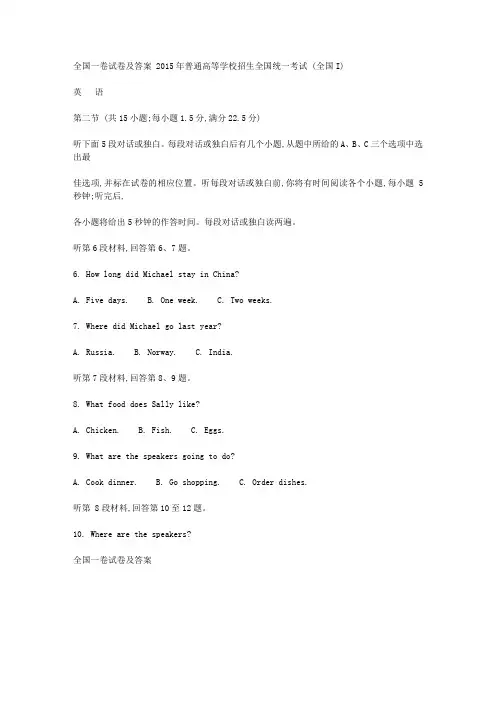
全国一卷试卷及答案 2015年普通高等学校招生全国统一考试 (全国I)
英语
第二节 (共15小题;每小题1.5分,满分22.5分)
听下面5段对话或独白。
每段对话或独白后有几个小题,从题中所给的A、B、C三个选项中选出最
佳选项,并标在试卷的相应位置。
听每段对话或独白前,你将有时间阅读各个小题,每小题5秒钟;听完后,
各小题将给出5秒钟的作答时间。
每段对话或独白读两遍。
听第6段材料,回答第6、7题。
6. How long did Michael stay in China?
A. Five days.
B. One week.
C. Two weeks.
7. Where did Michael go last year?
A. Russia.
B. Norway.
C. India.
听第7段材料,回答第8、9题。
8. What food does Sally like?
A. Chicken.
B. Fish.
C. Eggs.
9. What are the speakers going to do?
A. Cook dinner.
B. Go shopping.
C. Order dishes.
听第 8段材料,回答第10至12题。
10. Where are the speakers?
全国一卷试卷及答案。
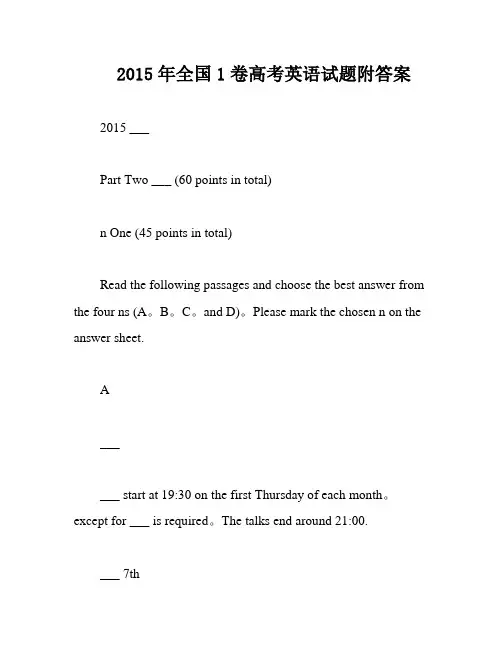
2015年全国1卷高考英语试题附答案2015 ___Part Two ___ (60 points in total)n One (45 points in total)Read the following passages and choose the best answer from the four ns (A。
B。
C。
and D)。
Please mark the chosen n on the answer sheet.A______ start at 19:30 on the first Thursday of each month。
except for ___ is required。
The talks end around 21:00.___ 7th___。
presented by Chris Lewis。
James ___ as one of the leading early ___。
He was also a major player in training others in the art of canal planning and building。
Chris Lewis will explain how ___ of that group of early "civil engineers".___ 5thIce for the Metropolis。
presented by Malcolm Tucker。
Long before the arrival of freezers。
there was a demand for ice for food n and catering。
Malcolm will explain the history of importing natural ice。
the technology of building ice wells。
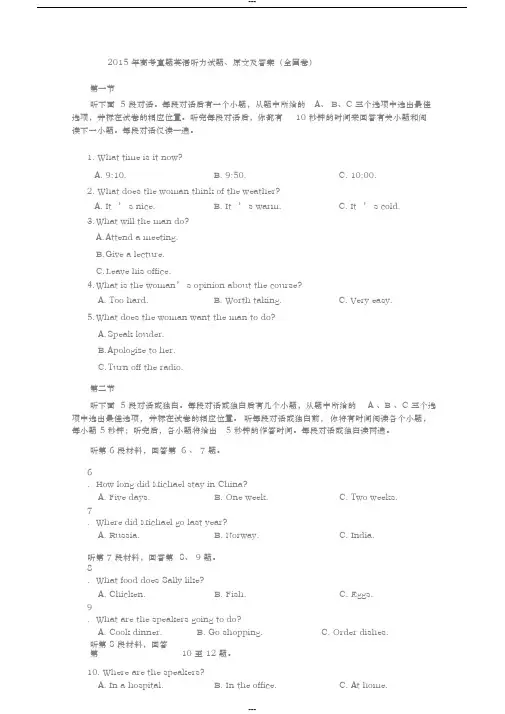
2015 年高考真题英语听力试题、原文及答案(全国卷)第一节听下面 5 段对话。
每段对话后有一个小题,从题中所给的A、 B、C 三个选项中选出最佳选项,并标在试卷的相应位置。
听完每段对话后,你都有10 秒钟的时间来回答有关小题和阅读下一小题。
每段对话仅读一遍。
1. What time is it now?A. 9:10.B. 9:50.C. 10:00.2. What does the woman think of the weather?A. It ’ s nice.B. It ’ s warm.C. It ’ s cold.3.What will the man do?A.Attend a meeting.B.G ive a lecture.C.Leave his office.4.What is the woman’ s opinion about the course?A. Too hard.B. Worth taking.C. Very easy.5.What does the woman want the man to do?A.Speak louder.B.A pologize to her.C.Turn off the radio.第二节听下面 5 段对话或独白。
每段对话或独白后有几个小题,从题中所给的 A 、B 、C 三个选项中选出最佳选项,并标在试卷的相应位置。
听每段对话或独白前,你将有时间阅读各个小题,每小题 5 秒钟;听完后,各小题将给出 5 秒钟的作答时间。
每段对话或独白读两遍。
听第 6 段材料,回答第6 、 7 题。
6. How long did Michael stay in China?A. Five days.B. One week.C. Two weeks.7. Where did Michael go last year?A. Russia.B. Norway.C. India.听第 7 段材料,回答第8、 9 题。
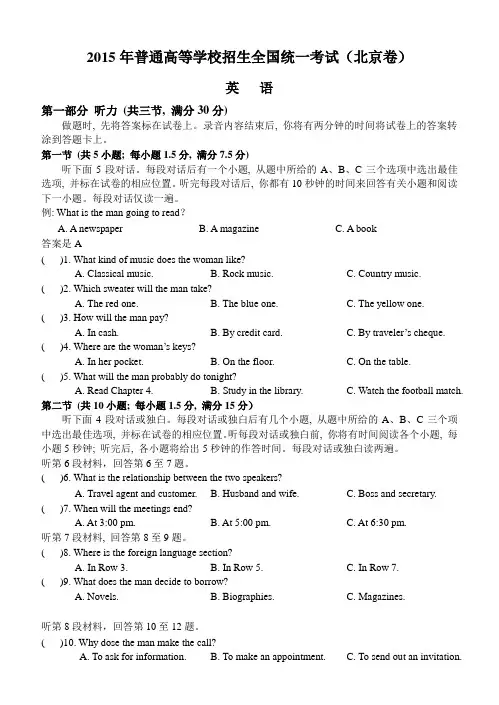
2015年普通高等学校招生全国统一考试(北京卷)英语第一部分听力(共三节, 满分30分)做题时, 先将答案标在试卷上。
录音内容结束后, 你将有两分钟的时间将试卷上的答案转涂到答题卡上。
第一节(共5小题; 每小题1.5分, 满分7.5分)听下面5段对话。
每段对话后有一个小题, 从题中所给的A、B、C三个选项中选出最佳选项, 并标在试卷的相应位置。
听完每段对话后, 你都有10秒钟的时间来回答有关小题和阅读下一小题。
每段对话仅读一遍。
例: What is the man going to read?A. A newspaperB. A magazineC. A book答案是A( )1. What kind of music does the woman like?A. Classical music.B. Rock music.C. Country music.( )2. Which sweater will the man take?A. The red one.B. The blue one.C. The yellow one.( )3. How will the man pay?A. In cash.B. By credit card.C. By traveler’s cheque. ( )4. Where are the woman’s keys?A. In her pocket.B. On the floor.C. On the table.( )5. What will the man probably do tonight?A. Read Chapter 4.B. Study in the library.C. Watch the football match. 第二节(共10小题; 每小题1.5分, 满分15分)听下面4段对话或独白。
每段对话或独白后有几个小题, 从题中所给的A、B、C三个项中选出最佳选项, 并标在试卷的相应位置。
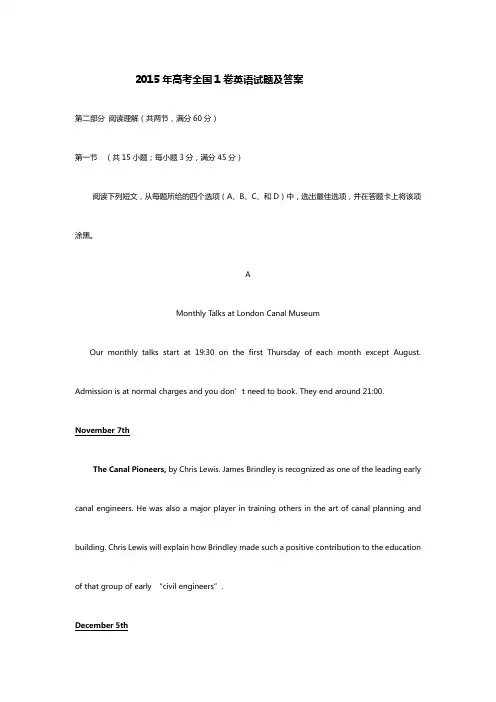
2015年高考全国1卷英语试题及答案第二部分阅读理解(共两节,满分60分)第一节(共15小题;每小题3分,满分45分)阅读下列短文,从每题所给的四个选项(A、B、C、和D)中,选出最佳选项,并在答题卡上将该项涂黑。
AMonthly T alks at London Canal MuseumOur monthly talks start at 19:30 on the first Thursday of each month except August. Admission is at normal charges and you don’t need to book. They end around 21:00. November 7thThe Canal Pioneers, by Chris Lewis. James Brindley is recognized as one of the leading early canal engineers. He was also a major player in training others in the art of canal planning and building. Chris Lewis will explain how Brindley made such a positive contribution to the education of that group of early “civil engineers”.December 5thIce for the Metropolis, by Malcolm Tucker. Well before the arrival of freezers, there was a demand for ice for food preservation and catering, Malcolm will explain the history of importing natural ice and the technology of building ice wells, and how London’s ice trade grew. February 6thAn Update on the Cotswold Canals, by Liz Payne. The Stroudwater Canal is moving towards reopening. The Thames and Severn Canal will take a little longer. We will have a report on the present state of play.March 6thEyots and Aits-Thames Islands,by Miranda Vickers. The Thames had many islands. Miranda has undertaken a review of all of them. She will tell us about those of greatest interest.Online bookings:/bookMore info:/whatsonLondon Canal Museum12-13 New Wharf Road, London NI 9RT www.canalmuseum.mobiTel************21.When is the talk on James Brindley?A. November 7th.B. March 6th.C. February 6th.D. December 5th.22. What is the topic of the talk in February?A. The Canal Pioneers.B. Ice for the MetropolisC. Eyots and Aits- Thames IslandsD. An Update on the Cotswold Canals23. Who will give the talk on the islands in the Thames?A. Chris LewisB. Malcolm TuckerC. Miranda VickersD. Liz PayneBThe freezing Northeast hasn’t been a terribly fun place to spend time this winter, so when the chance came for a weekend to Sarasota, Florida, my bags were packed before you could say “sunshine”. I left for the land of warmth and vitamin C(维生素C), thinking of beaches and orange trees. When we touched down to blue skies and warm air, I sent up a small prayer of gratefulness. Swimming pools, wine tasting, and pink sunsets(at normal evening hours, not 4 in the afternoon) filled the weekend, but the best part-particularly to my taste, dulled by months of cold-weather root vegetables-was a 7 a.m. adventure to the Sarasota farmers’market that proved to be more than worth the early wake-up call.The market, which was founded in 1979, sets up its tents every Saturday from 7 am to 1 p.m, rain or shine, along North Lemon and State streets. Baskets of perfect red strawberries, the red-painted sides of the Java Dawg coffee truck; and most of all, the tomatoes: amazing, large, soft and round red tomatoes.Disappointed by many a broken, vine-ripened(蔓上成熟的) promise, I’ve refused to buywinter tomatoes for years. No matter how attractive they look in the store, once I get them home they’re unfailingly dry, hard, and tasteless. But I homed in, with uncertainty, on one particular table at the Brown’s Grove Farm’s stand, full of fresh and soft tomatoes the size of my fist. These were the real deal- and at that moment, I realized that the best part of Sarasota in winter was going to be eating things that back home in New York I wouldn’t be experiencing again for months.Delighted as I was by the tomatoes in sight, my happiness deepened when I learned that Brown’s Grove Farm is one of the suppliers for Jack Dusty, a newly opened restaurant at the Sarasota Ritz Carlton, where-luckily for me-I was planning to have dinner that very night. Without even seeing the menu, I knew I’d be ordering every tomato on it.24. What did the author think of her winter life in New York?A. Exciting.B. Boring.C. Relaxing.D. Annoying.25. What made the author’s getting up early worthwhile?A. Having a swim.B. Breathing in fresh air.C. Walking in the morning sun.D. Visiting a local farmer’s market.26. What can we learn about tomatoes sold in New York in winter?A. They are soft.B. They look nice.C. They taste great.D. They are juicy.27. What was the author going to do that evening?A. Eat in a restaurant.B. Check into a hotel.C. Go to a farm.D. Buy fresh vegetables.CSalvador Dali (1904-1989) was one of the most popular of modern artists. The PompidouCentre in Paris is showing its respect and admiration for the artist and his powerful personality with an exhibition bringing together over 200 paintings, sculptures, drawings and more. Among the works and masterworks on exhibition the visitor will find the best pieces, most importantly The Persistence of Memory. There is also L’Enigme sans Fin from 1938, works on paper, objects, and projects for stage and screen and selected parts from television programmes reflecting the artist’s showman qualities.The visitor will enter the World of Dali through an egg and is met with the beginning, the world of birth. The exhibition follows a path of time and subject with the visitor exiting through the brain.The exhibition shows how Dali draws the viewer between two infinities (无限). “From the infinity small to the infinity large, contraction and expansion coming in and out of focus: amazing Flemish accuracy and the showy Baroque of old painting that he used in his museum-theatre in Figueras,”explains the Pompidou Centre.The fine selection of the major works was done in close collaboration (合作)with the Museo Nacional Reina Sofia in Madrid, Spain, and with contributions from other institutions like theSalvador Dali Museum in St. Petersburg, Florida.28. Which of the following best describes Dali according to Paragraph 1?A. Optimistic.B. ProductiveC. Generous.D. Traditional.29. What is Dali’s The Persistence of Memory considered to be?A. One of his masterworks.B. A successful screen adaptation.C. An artistic creation for the stage.D. One of the beat TV programmes.30. How are the exhibits arranged at the World of Dali?A. By popularity.B. By importance.C. By size and shape.D. By time and subject.31. What does the word “contributions”in the last paragraph refer to?A. Donations.B. Projects.C. Artworks.D. Documents.DConflict is on the menu tonight at the caféLa Chope. This evening, as on every Thursday night, psychologist Maud Lehanne is leading two of France’s favorite pastimes, coffee drinking and the “talking cure”. Here they are learning to get in touch with their true feelings. It isn’t always easy. The customers-some thirty Parisians who pay just under $2 (plus drinks) per session-are quick to intellectualize (高谈阔论),slow to open up and connect. “You are forbidden to say ‘one feels,’or ‘people think’,”Lehanne told them. “Say ‘I think,’‘Think me’.”A cafe society where no intellectualizing is allowed? It couldn’t seem more un-French. But Lehanne’s psychology cafe is about more than knowing oneself: It’s trying to help the city’s troubled neighborhood cafes. Over the years, Parisian cafes have fallen victim to changes in the French lifestyle-longer working hours, a fast-food boom and a younger generation’s desire to spend more time at home. Dozens of new theme cafes appear to change the situation. Cafes focused around psychology, history, and engineering are catching on, filling tables well into the evening.The city’s “psychology cafes”, which offer great comfort, are among the most popular places. Middle-aged homemakers, retirees, and the unemployed come to such cafes to talk about love, anger, and dreams with a psychologist. And they come to Lehanne’s group just to learn to say what they feel. “There’s a strong need in Paris for communication,”says Maurice Frisch, a cafe La Chope regular who works as a religious instructor in a nearby church. “People have few real friends.And they need to open up.”Lehanne says she’d like to see psychology cafes all over France. “If people had normal lives, these cafes wouldn’t exist,”she says. “If life weren’t a battle, people wouldn’t need a special place just to speak.”But then, it wouldn’t be France.32.What are people encouraged to do at the cafe La Chope?A. Learn a new subjectB. Keep in touch with friends.C. Show off their knowledge.D. Express their true feelings.33. How are cafes affected by French lifestyle changes?A. They have bigger night crowds.B. They stay open for longer hours.C. They are less frequently visited.D. They start to serve fast food.34. What are theme cafes expected to do?A. Save the cafe business.B. Supply better drinks.C. Create more jobs.D. Serve the neighborhood.35. Why are psychology cafes becoming popular in Paris?A. They bring people true friendship.B. They give people spiritual support.C. They help people realize their dreams.D. They offer a platform for business links.第二节(共5小题,每小题3分,满分15分)根据短文内容,从短文后的选项中选出能填入空白处的最佳选项,选项中有两项为多余选项。
2015年普通高等学校招生全国统一考试(全国卷1)英语本试卷分第I卷(选择题)和第II卷(非选择题)两部分。
考试结束后,将本试卷和答题卡一并交回。
第I卷第一部分听力(共两节, 满分30分)做题时, 先将答案标在试卷上。
录音内容结束后,你将有两分钟的时间将试卷上的答案转涂到答题卡上。
第一节(共5小题; 每小题1.5分, 满分7.5分)听下面5段对话。
每段对话后有一个小题,从题中所给的A、B、C三个选项中选出最佳选项, 并标在试卷的相应位置。
听完每段对话后, 你都有10秒钟的时间来回答有关小题和阅读下一小题。
每段对话仅读一遍。
例:How much isthe shirt?A.£19.15. B.£9.18.ﻩﻩC.£9.15.答案是C。
()1.Whattime is it now?A. 9:10 B.9:50 C.10:00()2. What does the woman think of the weather?A.It’snice. B. It’s warm. C. It’s cold.( )3.Whatwilltheman do?A. Attend a meeting.B. Givea lecture. C. Leave his office.( )4. What is thewoman’sopinion about the course?A.Too hard.B. Worth taking.C. Veryeasy.()5. What doesthe womanwantthe manto do?A. Speaklouder. B.Apologize to her.C.Turnoff the radio.第二节(共15小题; 每小题1.5分,满分22.5分)听下面5段对话或独白。
每段对话或独白后有几个小题, 从题中所给的A、B、C三个项中选出最佳选项,并标在试卷的相应位置。
听每段对话或独白前,你将有时间阅读各个小题, 每小题5秒钟; 听完后,各小题将给出5秒钟的作答时间。
2015年普通高等学校招生全国统一考试(四川卷)英语本试题卷分第Ⅰ卷(选择题)和第Ⅱ卷(非选择题)。
第Ⅰ卷至8页,第Ⅱ卷9至10页,共10页。
满分150分。
考试时间120分钟。
考生作答时,须将答案答在答题卡上,在本试题卷、草纸上答题不小。
考试结束后,将本试题卷和答题卡一并交回第Ⅰ卷(选择题共90分)注意事项:1.必须使用2B铅笔在答题卡上将所选答案对应的标号涂黑2.第Ⅰ卷共两部分,共计90分。
第一部分英语知识运用(共两节,共40分)第一节单项填空从A、B、C、D四个选项中,选出可以填入空白处的最佳选项,并在答题卡上将该项涂黑。
(共10小题;每小题1分,共10分)1.—Sorry,I forgot to lock the door.—______Mike can do it later..A.No wayB.Take your timeC.Nothing seriousD.You'rewelcome2.You_____be careful with the camera.It costs!A.mustB.mayC.canD.will3.The books on the desk,covers are shiny,are prizes for us.A.whichB.whatC.whoseD.that4.More expressways in Sichuan soon to promote the local economy.A.are being builtB.will be builtC.have been builtD.had been built5.Brian is gifted in writing music;he is very likely to be Beethoven.A.aB.anC.theD.不填6.There is only one more day to go your favorite music group play live.A.sinceB.untilC.whenD.before7.Andy is content with the toy.It is he has ever got.A.a betterB.the betterC.a bestD.the best8.The exhibition tells us we should do something to stop air pollution.A.whereB.whyC.whatD.which9.Little Tom sat watching the monkey dancing in front of him.A.amazeB.amazingC.amazedD.to amaze10.Niki is always full of ideas,but is useful to my knowledge.A.nothingB.no oneC.neitherD.none第二节完形填空阅读下面短文,从短文后各题所给的四个选项(A、B、C、D)中,选出可以填入空白处的最佳选项,并在答题卡上将该项涂黑。
2020高考英语“七选五”阅读理解专项突破原创系列资料105 英语高考“七选五”阅读理解真题详解52015全国卷I【高考真题解题例析】为了让大家能把上面所提到的解题原则、方法和步骤能运用到具体的解题实践之中,下面以2015年英语高考全国卷I中的“七选五”阅读理解试题的解答为例来说明如何解题。
【高考真题】根据短文内容,从短文后的选项中选出能填入空白处的最佳选项。
选项中有两项为多余选项。
Building Trust in a Relationship AgainTrust is a learned behavior that we gain from past experiences. 36 .Trust is a risk. But you can’t be successful when there’s a lack of trust in a relationship that results from an action where the wrongdoer takes no responsibility to fix the mistake.Unfortunately, we’ve all been victims of betrayal. Whether we’ve been suffer from, lied to, misled, or cheated on, there are different levels of losing trust. Sometimes people simply can’t trust anymore. 37 It’s understandable, but if you’re willing to build trust in a relationship again, we have some steps you can take to get you there.●38 Having confidence in yourself will help you make better choices because you can see what the best outcome would be for your well-being.●39 If you’ve been betrayed, you are the victim of your circumstance. But there’s a difference between being a victim and living with a “victim mentality”. At some point in all of our lives, we’ll have our trust tested or violated.●You didn’t lose “everything”. Once trust is lost, what is left? Instead of looking at the situation from this hopeless angle, look at everything you still have and be thankful for all ofthe good in your life. 40 Instead, it’s a healthy way to work through the experience to allow room for positive growth and forgiveness.A. Learn to really trust yourself.B. It is putting confidence in someone.C. Stop regarding yourself as the victim.D. Remember that you can expect the best in return.E. They’ve been too badly hurt and they can’t bear to let it happen again.F. This knowledge carries over in their attitude toward their future relationships.G. Seeing the positive side of things doesn’t mean you’re ignoring what happened.【语篇解读】【解题图解】A. Learn to really trust yourself.B. It is putting confidence in someone. 36C. Stop regarding yourself as the victim. 39D. Remember that you can expect the best in return.E. They’ve been too badly hurt and they can’t bear to let it happen again. 37F. This knowledge carries over in their attitude toward their future relationships.G. Seeing the positive side of things doesn’t mean you’re ignoring what happened. 40【答案解析】1. 通过快速浏览浏览全文,由文章的题目、每段的首段和文中的项目符号便可知本文的主题是如何重建人际关中的信任,文章可以分为两个部分,第一部分由一、二段组成,用于引入话题及说明为什么要重建人际关中的信任,第二部分由三、四、五段组成,提出了重建人际关中的信任的三个步骤,是一篇介绍方法步骤类的说明文。
英语本试卷分第I卷(选择题)和第II卷(非选择题)两部分,考试结束后,将本试卷和答题卡一并交回。
注意事项:1. 答第I卷前,考生务必将自己的姓名、考生号填写在答题卡上。
2. 选出每小题答案后,用铅笔把答题卡上对应题目的答案标号涂黑。
如需改动,用橡皮擦干净后,再选涂其他答案标号。
不能答在本试卷上,否则无效。
第一部分听力(共两节, 满分30分)做题时,先将答案标在试卷上。
录音内容结束后,你将有两分钟的时间将试卷上的答案转涂到答题卡上。
第一节(共5小题;每小题1.5分,满分7.5分)听下面5段对话。
每段对话后有一个小题,从题中所给的A、B、C三个选项中选出最佳选项,并标在试卷的相应位置。
听完每段对话后,你都有10称钟的时间来回答有关小题和阅读下一小题。
每段对话仅读一遍。
例: How much is the shirt? A. £19.15. B. £9.18. C. £9.15. 答案是C。
1. What time is it now?A. 9:10.B. 9:50.C. 10:00.2. What does the woman think of the weather?A. It’s nice.B. It’s warm.C. It’s cold.3. What will the man do?A. Attend a meeting.B. Give a lecture.C. Leave his office.4. What is the woman’s opinion about the course?A. Too hard.B. Worth taking.C. Very easy.5. What does the woman want the man do?A. Speak louder.B. Apologize to her.C. Turn off the radio.第二节(共15小题;每小题1.5分,满分22.5分)听下面5段对话或独白。
2015年普通高等学校招生全国统一考试(四川卷)英语本试题卷分第Ⅰ卷(选择题)和第Ⅱ卷(非选择题)。
满分150分。
考试时间120分钟。
考生作答时,须将答案答在答题卡上,在本试题卷、草纸上答题不小。
考试结束后,将本试题卷和答题卡一并交回。
第Ⅰ卷(选择题共90分)注意事项:1.2.第一节从A(共101. ——2.3.4.5.A. a6.A. sinceB. untilC. whenD. before7. Andy is content with the toy.It is __________ he has ever got.A. a betterB. the betterC. a bestD. the best8. The exhibition tells us __________ we should do something to stop air pollution.A. whereB. whyC. whatD. which9. Little Tom sat __________ watching the monkey dancing in front of him.A. amazeB. amazingC. amazedD. to amaze10. Niki is always full of ideas,but __________ is useful to my knowledge.A. nothingB. no oneC. neitherD. none第二节完形填空阅读下面短文,从短文后各题所给的四个选项(A、B、C、D)中,选出可以填入空白处的最佳选项,并在答题卡上将该项涂黑。
(共20小题;每小题1.5分,共30分)My previous home had a stand of woods behind it and many animals in the backyard. That first year, I 11 feeding peanuts to the blue jays, then the squirrels. The squirrels had no ___12___ coming up right to me for them. As the months went by, the rabbits saw that I was no 13 and didn’t escape When I threw carrot slices(薄片), they even came for a nibble(啃). Slowly they came to___14___ me, and by the end of the year they were eating out of my hand.___19___, there were times I would have the groundhog sitting next to a rabbit,both munching(津津有___21___ when she was facing away,I reached out and___26_11.12.13.14.15.16.17. A. extreme B. increasing C. additional D. inspiring18. A. squirrel B. rabbit C. peanut D. carrot19. A. before long B. long ago C. over and over D. all over again20. A. eating B. playing C. sitting D. sleeping21. A. Next B. Once C. Soon D. Lately22. A. carefully B. suddenly C. violently D. patiently23. A. also B. thus C. just D. still24. A. thought B. doubted C. admitted D. recognised25. A. While B. Or C. So D. For26. A. fixed B. placed C. hung D. kept27. A. tremble B. move C. delay D. hesitation28. A. Even if B. Ever since C. As far as D. So long as29. A. welcomed B. required C. bothered D. expected30. A. trade B. competition C. task D. affair第二部分阅读理解(共两节,共50分)第一节阅读下列短文,从每题所给的四个选项(A、B、C、D)中,选出最佳选项,并在答题卡And every week he cleaned Old Man McColgin's chicken house in exchange for manure(肥料). The Smell really burned the inside of your nose. When we complained about the terrible smell, Dad said the stronger the manure, the healthier the crops, and he was right. For example, just one of his cantaloupes filled the entire house with its sweet smell, and the taste was even sweeter.As the vegetables started coming in, Dad threw himself into cooking. One day, armed with a basket of vegetables, he announced he was going to make stew(炖菜).Dad pulled out a pressure cooker and filled it up with cabbages, eggplants, potatoes, corns, onions and carrots. For about half an hour. the pressure built and the vegetables cooked. Finally, Dad turned off the stove, the pot began to cool andthe pressure relief valve sprayed out a cloud of steam. If we thought Dad's pile of chicken manure。
2015 年普通高等学校招生全国统一考试英语(北京卷)本试卷共16 页,共150 分。
考试时间为120 分钟。
考生务必将答案答在答题卡上,在试卷上作答无效。
考试结束后,将本试卷和答题卡一并交回。
第一部分:听力理解(共三节:30 分)第一节(共 5 小题;每小题 1.5 分,共7.5 分)听下面5 段对话。
每段对话后有一道小题,从每题所给的A、B、C 三个选项中选出最佳选项。
听完每段对话后,你将有10 秒钟的时间来回答有关小题和阅读下一小题,每段对话你将听一遍。
例:What is the man going to read?A.A newspaperB.A magazineC.A book 答案是A1.What kind of music does the woman like?A.Classical musicB. Rock musicC. Country music2.Which sweater will the man take?A.The red one B。
The blue one C. The yellow one3.H ow will the man pay?A.In cashB. By credit cardC. By traveler’s cheque4.W here are the woman’s keys?A.In her pocketB. On the floorC. On the table5.W hat will the man probably do tonight?A.Read Chapter 4B.Study in the libraryC.Watch the football match第二节(共10 小题;每小题1.5 分,共15 分)听下面4 段对话或独白。
每段对话或独白后有几道小题,从每题所给的A、B、C 三个选项中选出最佳选项。
听每段对话或独白前,你将有5 秒钟的时间阅读每小题。
2015 年普通高等学校招生全国统一考试(全国I)英语本试卷分第I 卷(选择题)和第II 卷(非选择题)两部分,考试结束后,将本试卷和答题卡一并交回。
注意事项:1. 答第I 卷前,考生务必将自己的姓名、考生号填写在答题卡上。
2. 选出每小题答案后,用铅笔把答题卡上对应题目的答案标号涂黑。
如需改动,用橡皮擦干净后,再选涂其他答案标号。
不能答在本试卷上,否则无效。
第一部分听力(共两节, 满分30 分)做题时,先将答案标在试卷上。
录音内容结束后,你将有两分钟的时间将试卷上的答案转涂到答题卡上。
第一节(共5 小题;每小题 1.5 分,满分7.5 分)听下面 5 段对话。
每段对话后有一个小题,从题中所给的A、B、C 三个选项中选出最佳选项,并标在试卷的相应位置。
听完每段对话后,你都有10 称钟的时间来回答有关小题和阅读下一小题。
每段对话仅读一遍。
例: How much is the shirt? A. £19.15. B. £9.18. C. £9.15. 答案是C。
1. What time is it now?A. 9:10.B. 9:50.C. 10:00.2. What does the woman think of the weather?A. It ?s nice.B. It ?s warm.C. It ?s cold.3. What will the man do?A. Attend a meeting.B. Give a lecture.C. Leave his office.4. What is the woman ?s opinion about the course?A. Too hard.B. Worth taking.C. Very easy.5. What does the woman want the man do?A. Speak louder.B. Apologize to her.C. Turn off the radio.第二节(共15 小题;每小题 1.5 分,满分22.5 分)听下面 5 段对话或独白。
每段对话或独白后有几个小题,从题中所给的A、B、C 三个选项中选出最佳选项,并标在试卷的相应位置。
听每段对话或独白前,你将有时间阅读各个小题,每小题 5 秒钟;听完后, 各小题将给出 5 秒钟的作答时间。
每段对话或独白读两遍。
听第 6 段材料,回答第6、7 题。
6. How long did Michael stay in China?A. Five days.B. One week.C. Two weeks.7. Where did Michael go last year?A. Russia.B. Norway.C. India.听第7 段材料,回答第8、9 题。
8. What food does Sally like?A. Chicken.B. Fish.C. Eggs.9. What are the speakers going to do?A. Cook dinner.B. Go shopping.C. Order dishes.听第8 段材料,回答第10 至12 题。
10. Where are the speakers?A. In a hospital.B. In the office.C. At home.11. When is the report due?A. Thursday.B. Friday.C. Next Monday.3. What does George suggest Stephanie do with the report?A. Improve it.B. Hand it in later.C. Leave it with him.听第9 段材料,回答第13 至16 题。
4.What is the probable relationship between the speakers?A. Salesperson and customer.B. Homeowner and cleaner.C. Husband and wife.5.What kind of apartment do the speakers prefer?A. One with two bedrooms.B. One without furniture.C. One near a market.6.How much rent should one pay for the one-bedroom apartment?A.$350.B. $400.C. $415.7.Where is the apartment the speakers would like to see?A. On Lake Street.B. On Market.C. On South Street.听第10 段材料,回答第17 至20 题。
8.What percentage of the world ?s tea exports go to Britain?A. Almost 15%.B. About 30%.C. Over 40%.9.Why do tea tasters taste tea with milk?A. Most British people drink tea that way.B. Tea tastes much better with milk.C. Tea with milk is healthy.10.Who suggests a price for each tea?A. Tea tasters.B. Tea exporters.C. Tea companies.11.What is the speaker talking about?A. The life of tea tasters.B. Afternoon tea in Britain.C. The London Tea Trade Centre. 第二部分阅读理解(共两节,满分40 分)第一节(共15 小题;每小题 2 分,满分30 分)阅读下列短文,从每题所给的四个选项(A、B、C、和D)中,选出最佳选项,并在答题卡上将该项涂黑。
AMonthly Talks at London Canal MuseumOur monthly talks start at 19:30 on the first Thursday of each month except August. Admission is at normal charges and you don?t need to book. They end around 21:00.November 7thThe Canal Pioneers, by Chris Lewis. James Brindley is recognized as one of the leading early canal engineers. He was also a major player in training others in the art of canal planning and building. Chris Lewiswill explain how Brindley made such a positive contribution to the education of that group of early “civil engineers ”.December 5thIce for the Metropolis, by Malcolm Tucker. Well before the arrival of freezers, there was a demand forice for food preservation and catering, Malcolm will explain the history of importing natural ice and the technology of building ice wells, and how London?s ice trade grew.February 6thAn Update on the Cotswold Canals , by Liz Payne. The Stroudwater Canal is moving towards reopening. The Thames and Severn Canal will take a little longer. We will have a report on the present state of play.March 6thEyots and Aits-Thames Islands, by Miranda Vickers. The Thames had many islands. Miranda hasundertaken a review of all of them. She will tell us about those of greatest interest.Online bookings:/bookMore info : /whatsonLondon Canal Museum12-13 New Wharf Road, London NI 9RT www. canalmuseum.mobiTel************12.When is the talk on James Brindley?A. November 7th.B. March 6th.C. February 6th.D. December 5th.13. What is the topic of the talk in February?A. The Canal Pioneers.B. Ice for the Metropolis.C. Eyots and Aits-Thames Islands.D. An Update on the Cotswold Canals.14. Who will give the talk on the islands in the Thames?A. Chris Lewis.B. Malcolm Tucker.C. Miranda Vickers.D. Liz Payne.BThe freezing Northeast hasn?t been a terribly fun place to spend time this winter, so when the chance camefor a weekend to Sarasota, Florida, my bags were packed before you could say “sunshine ”. I left fowarmth and vitamin C ( 维生素C), thinking of beaches and orange trees. When we touched down to blue skiesand warm air, I sent up a small prayer of gratefulness. Swimming pools, wine tasting, and pink sunsets(atnormal evening hours, not 4 in the afternoon) filled the weekend, but the best part —particularly to my taste,dulled by months of cold-weather root vegetables —was a 7 a.m. adventure to the Sarasota farmers? market thatproved to be more than worth the early wake-up call.The market, which was founded in 1979, sets up its tents every Saturday from 7:00 am to 1 p.m., rain orshine, along North Lemon and State streets. Baskets of perfect red strawberries, the red-painted sides of theJava Dawg coffee truck; and most of all, the tomatoes: amazing, large, soft and round red tomatoes.Disappointed by many a broken, vine-ripened ( 蔓上成熟的) promise, I?ve refused to buy winter tomatoesfor years. No matter how attractive they look in the store, once I get them home they?re unfailingly dry, hard,and tasteless. But I homed in, with uncertainty , on one particular table at the Brown?s Grove Farm?s stand, fullof fresh and soft tomatoes the size of my fist. These were the real deal —and at that moment, I realized that thebest part of Sarasota in winter was going to be eating things that back home in New York I wouldn?t be experiencing again for months.Delighted as I was by the tomatoes in sight, my happiness deepened when I learned that Brown?s GroveFarm is one of the suppliers for Jack Dusty, a newly opened restaurant at the Sarasota Ritz Carlton, where ―luckily for me —I was planning to have dinner that v ery night. Without even seeing the menu, I knew I?d beordering every tomato on it.15. What did the author think of her winter life in New York?A. Exciting.B. Boring.C. Relaxing.D. Annoying.16. What made the author?s getting up early worth while?A. Having a swim.B. Breathing in fresh air.C. Walking in the morning sun.D. Visiting a local farmer?s market.17. What can we learn about tomatoes sold in New York in winter?A. They are soft.B. They look nice.C. They taste great.D. They are juicy.18. What was the author going to that evening?A. Eat in a restaurant.B. Check into a hotel.C. Go to a farm.D. Buy fresh vegetables.CSalvador Dali (1904 ―1989) was one of the most popular of modern artists. The Pompidou Centre in Parisis showing its respect and admiration for the artist and his powerful personality with an exhibition bringing together over 200 paintings, sculptures, drawings and more. Among the works and masterworks on exhibitionthe visitor will find the best pieces, most importantly The Persistence of Memory. There is also L’Enigme sansFin from 1938, works on paper, objects, and projects for stage and screen and selected parts from television programmes reflecting the artist?s showman qualities.The visitor will enter the World of Dali through an egg and is met with the beginning, the world of birth.The exhibition follows a path of time and subject with the visitor exiting through the brain.The exhibition shows how Dali draws the viewer between two infinities ( 无限). “From the infinity small tothe infinity large, contraction and expansion coming in and out of focus: amazing Flemish accuracy and theshowy Baroque of old painting that he used in his museum- theatre in Figueras, ”explains the Pompidou Centre.The fine selection of the major works was done in close collaboration (合作) with the Museo NacionalReina Sofia in Madrid, Spain, and with contributions from other institutions like the Salvador Dali Museum inSt. Petersburg, Florida.19. Which of the following best describes Dali according to Paragraph 1?A. Optimistic.B. ProductiveC. Generous.D. Traditional.20. What is Dali?s The Persistence of Memory considered to be?A. One of his masterworks.B. A successful screen adaptation.C. An artistic creation for the stage.D. One of the best TV programmes.21. How are the exhibits arranged at the World of Dali?A. By popularity.B. By importance.C. By size and shape.D. By time and subject.22. What does the word “contributions ”in the last paragraph refer to?A. Donations.B. Projects.C. Artworks.D. Documents.DConflict is on the menu tonight at the cafe La Chope. This evening, as on every Thursday night, psychologist Maud Lehanne is leading two of France?s favorite pastimes, coffee drinking and theHere they are learning to get in touch with their true feelings. It isn?t always easy. The customers —some thirty Parisians who pay just under $ 2 (plus drinks) per session —are quick to intellectualize ( 高谈阔论), slow to openup and connect. “You are forbidden to say ,one feels?, or ,people think?L,ehann e told them. ”“Say ,I think?,,Think me?. ”A cafe society where no intellectualizing is allowed? It couldn?t seem more un-French. But Lehanne?s psychology cafe is about more than knowing oneself: It?s trying to help the city?s troubled neighborhood cafes.Over the years, Parisian cafes have fallen victims to changes in the French lifestyle —longer working hours, afast-food boom and a younger generation?s desire to spend more time at home. Dozens of new theme cafes appear to change the situation. Cafes focused around psychology, history, and engineering are catching on,filling tables well into the evening.The city ?s“psychology cafes”, which offer great comfort, are among the most popular places. Middle-aged homemakers, retirees, and the unemployed come to such cafes to talk about love, anger, and dreams with a psychologist. And they come to Lehanne ?s group just to learn to say what they feel. “There is astrong need in Paris for communication, ”says Maurice Frisch, a cafe La Chope regular who works as a religious instructor in a nearby church. “People have few real friends. And they need to open up. ”Lehanne saysshe?d like to see psychology cafes all over France. “If people had normal lives, these cafes wouldn ?t exist,”she says. “If life weren?t a battle, people wouldn ?t need a special place just to speak.”But then, it wouldn ?t beFrance.23.What are people encouraged to do at the cafe La Chope?A. Learn a new subject.B. Keep in touch with friends.C. Show off their knowledge.D. Express their true feelings.24. How are cafes affected by French lifestyle changes?A. They have bigger night crowds.B. They stay open for longer hours.C. They are less frequently visited.D. They start to serve fast food.25. What are theme cafes expected to do?A. Save the cafe business.B. Supply better drinks.C. Create more jobs.D. Serve the neighborhood.26. Why are psychology cafes becoming popular in Paris?A. They bring people true friendship.B. They give people spiritual support.C. They help people realize their dreams.D. They offer a platform for business links.第二节(共5 小题,每小题 2 分,满分10 分)根据短文内容,从短文后的选项中选出能填入空白处的最佳选项,选项中有两项为多余选项。